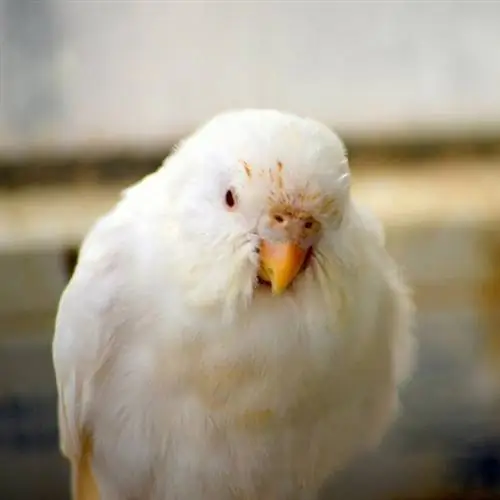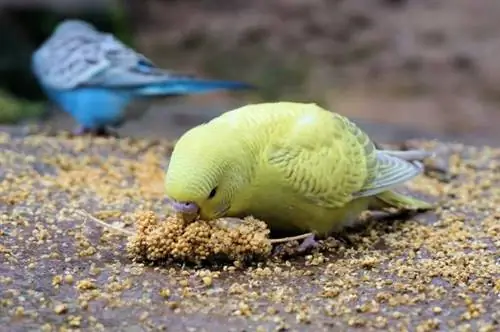- Author Carl Johnson [email protected].
- Public 2023-12-16 06:19.
- Last modified 2025-01-23 08:59.

Parakeets are birds psitaciformes originating in Australia that are very successful as pets in our homes, both for their plumage with great diversity of color as well as for its endearing character and its easy care.
As members of the order Psittaciformes, parakeets have a robust and curved beak, but it is not uncommon for one of our little companions to crack it, which is why we must know how to act to take care of it of the cracked beak of our parakeet.
In this article on our site.com we are going to explain how to cure a parakeet's cracked beak.
The consequences of a cracked beak
A budgerigar's cracked beak would be like a broken tooth in a human: the nerve endings and bones are connected to the beak, so this type of damage it's painful for our parakeet.
It is important to differentiate the case of a beak that is simply cracked or fissured from a beak with more serious damage, such as a fracture or amputated beak, which can cause excessive bleeding given the abundant blood flow that reaches to the peak In case of blood loss we have to apply pressure to stop the bleeding and call a vet as soon as possible.
If it is indeed a cracked beak, we must know that the two sides of a cracked beak will not grow together, but rather more and more apart.
What should I do?
Some advise using super glue to glue down a cracked beak, but you should never do it yourself. Indeed, the glues are toxic and can also penetrate the eyes, the nostrils, and inside the mouth. So, it should be an act performed only by a veterinarian.
Actually, in most cases of cracked beaks, if the crack is small, it doesn't seem to bother our parakeet and it doesn't bleed, we just leave it so that, over time,grow a he althy beak , exactly as happens when we have a cracked nail.
It is important to make sure that we have cuttlefish or calcium bones so that our bird naturally wears out its beak, thus avoiding overgrowth of this and, little by little, over time the cracked part will wear down and the he althy beak will grow.
And if the crack is big?
A cracked beak implies a risk of possible infection and increases the chances that our bird will not be able to feed properly.
If the fissure were very high or deep, the beak of our parakeet could lose drops of blood, a fact that can cause an increase in blood pressure and, therefore, worsen the bleeding. This type of bleeding may not cause severe pain to our parakeet, but it does cause such a significant loss of blood that it could even lead to the death of the bird, so we must act quickly to stop the bleeding. To do this, we can create a plug with mild soap, rubbing the affected area from the bottom up with a bar of soap. This is a temporary and emergency remedy to treat the cracked beak of our parakeet, what we must do immediately afterwards is to go to our trusted veterinarian, especially if it suffers this type of bleeding, drop by drop, as it is a serious case that we must take very seriously.

Immediate care
If the beak is falling off or if its outer layers are damaged, underlying tissues may dry out. In such cases, we can flush the wound with sterile saline (a preservative-free contact lens solution works well) to remove any debris and to help keep the tissue moist until the bird is examined by a veterinarian. We have to be gentle when cleaning the beak and be careful not to separate or remove the beak if it is still partially attached.
The vet may say to cut off part of the beak or attach it with a special plasteruntil it grows back he althy. At the veterinary hospital, our parakeet may be fed with a feeding tube, then while his beak has not fully grown we will give him soft and wet food
Long Term Care
In the case of a small beak wound, give supportive care, antimicrobial agents , and pain medication should be enough until the wound is gone thanks to the growth of the new, he althy beak.
With a larger wound, dental acrylic in resin and fixative lightmay be used to hold the beak together until the he althy beak.
A beak fracture can be completely healed if blood flow continues well. However, some injuries to our parakeet's beak could be permanent, meaning the bird would need to eat soft food all its life.






